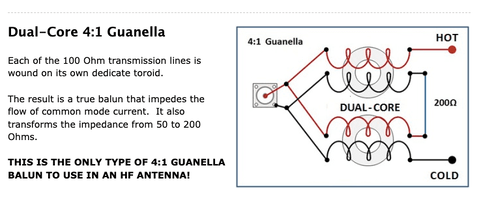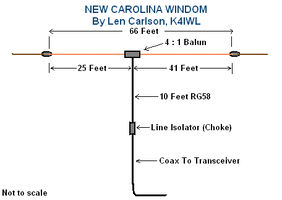rogersmithiii
NES Member
- Joined
- Feb 19, 2008
- Messages
- 2,914
- Likes
- 4,192
If you enjoy the forum please consider supporting it by signing up for a NES Membership The benefits pay for the membership many times over.



Well...partially true. A yagi tri-bander willNothing beats a resonant dipole on HF.
The antenna can be used without the vertical radiator but the radiation pattern will lose the low angle component and may make the antenna less effective. If the vertical radiator is removed then you should move the line isolator to the bottom of the balun.

One thing DJ0IP mentions is that:
ALL of the companies manufacturing OCFD antennas commercially are still using the single core 4:1 Guanella, and under certain circumstances can incur severe common mode current problems.
The only exceptions I know of are Spiderbeam and DX-Wire, two German antenna companies.
This is not necessarily true...my OCFD made by Palomar Engineering is a hybrid balun with the 4:1 part having dual cores. The 1:1 Unun, which keeps common mode RF current off the feedline is, I believe, a single core. Both "baluns" are inside a weatherproof plastic box.
They are very slow to ship though, or at least were back a few years ago. I ordered my OCFD from them and a month later, even with multiple emails unanswered, I sent them an email cancelling the order...I guess that's what it took because within 30 minutes I received an email from them confirming the cancellation. I called a buddy at HRO Salem that I used to work with when I worked there and he had one shipped that day and it was cheaper than Palomar and free shipping to boot. I had it the next day (I was still living in NH at the time).I, too, have had great luck with Palomar's products.
They are very slow to ship though, or at least were back a few years ago. I ordered my OCFD from them and a month later, even with multiple emails unanswered, I sent them an email cancelling the order...I guess that's what it took because within 30 minutes I received an email from them confirming the cancellation. I called a buddy at HRO Salem that I used to work with when I worked there and he had one shipped that day and it was cheaper than Palomar and free shipping to boot. I had it the next day (I was still living in NH at the time).
I am running RG8x to it and running some power 700-800 watts (SSB) occasionally which might be OK but I have some RG-213 somewhere that I will eventually replace the 8x with.
A resonant yagi?Nothing beats a resonant dipole on HF.

You DO know that antennas put up in crappiest weather work the best, right?Well, I got the 4:1 into a box and ready to go. If the weather cooperates I'll see about getting it in the air and tuning the wires.

What did you do in the shack today?
I have always wondered if this forum had a "What did you do..." thread like others on NES. A search appears to show that it does not. So I will start off... Today in the shack I began manufacturing coax jumpers using RF Industries RFU-508X crimp connectors on Ventev/Terrawave TWS-240 cable...www.northeastshooters.com
Yeah, I'm hoping for snow/ice. And since I'll have to tune wires, wind.You DO know that antennas put up in crappiest weather work the best, right?
Inversely proportional rule here.
Bow & arrow with fishing line?I don't know how people navigate through all the branches when they setup antennas.
The best thing I've bought for getting rope high in the tree is a pneumatic launcher. It puts a 2oz fishing weight over a 100' tall tree with ease. I bought it on ebay last year but it looks like they aren't selling it any longer. They still have the weights but no launcher. I wonder if some ambulance chasing lawyer told them it is "too dangerous".I don't know how people navigate through all the branches when they setup antennas.
Ahhh... that does pose some issues. I've been trying figure how to erect a fullwave 160 loop but I don't have trees in the right place. I definitely have the room but nothing in the right places. I'm actually thinking about approaching the power company out here and see if they would sell me four 60' utility poles (and how much they'd be).I guess my problem is always that I'm in the trees, not going from one tree, across a clear field to another tree. I can get the center pulled up, but now the two legs of the dipole have to get up to the center point and woven through all the other trees and branches to a point I can tie them off. And the center of this thing is heavy with two boxes of toroids hanging off it, so I have to support the center for sure.
